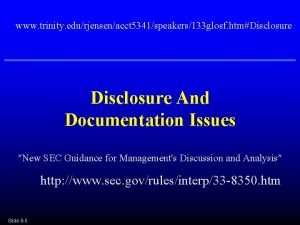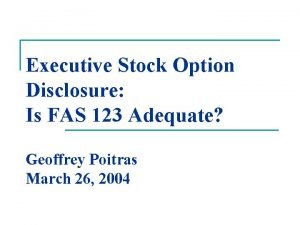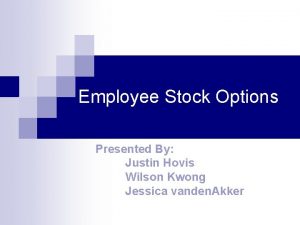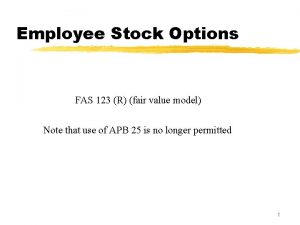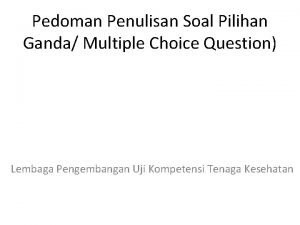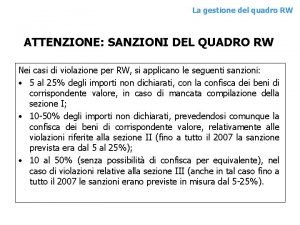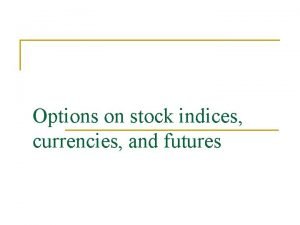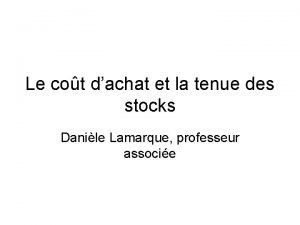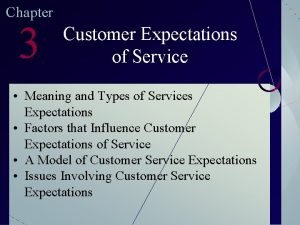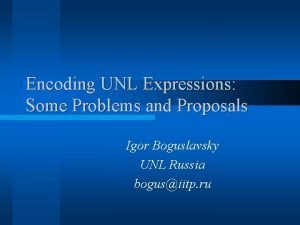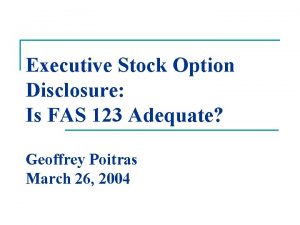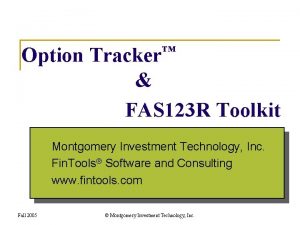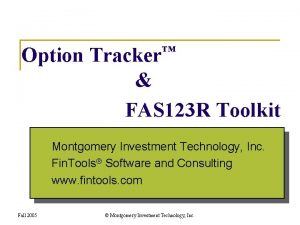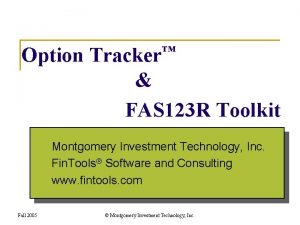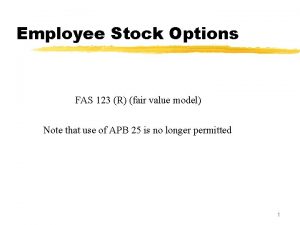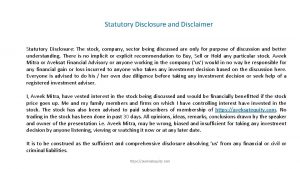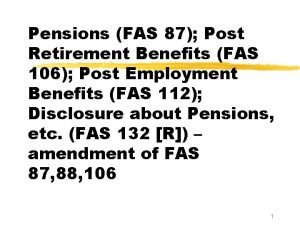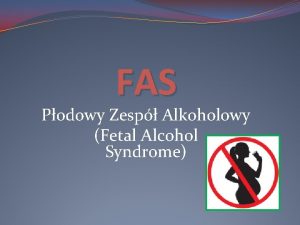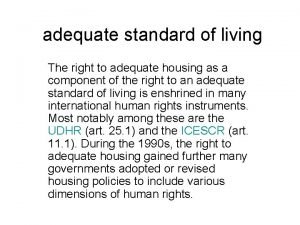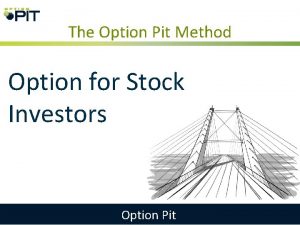Executive Stock Option Disclosure Is FAS 123 Adequate
















- Slides: 16

Executive Stock Option Disclosure: Is FAS 123 Adequate? Geoffrey Poitras March 26, 2004

Problems With Stock Options n “You issue stock options to reduce compensation expense and therefore increase your profitability. ” n Jeffrey Skilling, former CEO of Enron Co.

Types of Stock Options n Employee Stock Options (ESOs) v Hall and Murphy (2003) the average outstanding amount of ESOs for an average S&P 500 firm increased over tenfold from $22 million in 1992 to $238 million per company in 2000. v Over 90% of ESOs were given to employees other than the top five executives, with the share of stock options granted to the CEO falling from over 7% to under 5%.

Expensing of Stock Options n Given the small size of Ex. SOs relative to total ESOs, Ex. SOs play a secondary role in the debate over the accurate ‘expensing’ of contingent stock based compensation. n APB 25 and FAS 123 – focus on ESOs n The International Employee Stock Option Coalition (www. savestockoptions. org). n The issue of ‘fair value’ calculations

Executive Stock Options (Ex. SOs) n Executive stock options are only a fraction of the total amount of ESOs outstanding n Four components executive compensation: base salary; annual bonus tied to accounting performance; stock options; and long-term incentive plans, including restricted stock plans and multi-year accounting-based performance plans.

Usage of Executive Stock Options n Murphy (1999): median cash compensation paid to S&P CEOs more than doubled since 1970 while the median total realized compensation, including gains from exercising stock options, nearly quadrupled, almost twice the increase in the median cash compensation for the same period n Murphy (2003): over the 1990 s, the stock option component of CEO pay for the S&P 500 Industrials, valued on the grant date, increased five times in dollar terms, from 27 percent in 1992 to 51 percent of total compensation in 2000.

Positive Rationales for Ex. SOs n “Although options are clearly an inefficient way of attracting, retaining and motivating lower-level employees, the case for options for top executives is more compelling” Hall and Murphy (2003) n Huddart and Lang (1996): “the absence of a charge against accounting income for most option compensation, favorable tax treatment and positive incentive effect of linking employee compensation to share price”. n Optimal contracting theory

Negative Rationales for Ex. SOs n Managerial power and corporate governance v Ex. SOs are a mechanism to “camouflage” inefficient wealth transfers from shareholders to “greedy executives” (Hall and Murphy 2003, p. 64). Rather than being a potential solution to the agency problem, the managerial rent seeking approach views Ex. SOs as a product of the agency problem. v

Current ESO Disclosure Requirements n The APB 25 standard permits companies to account for ESOs using ‘intrinsic value’: the difference between the stock price and the option exercise price. n The general practice of making option grants at-the-money produces an intrinsic value of zero, on the grant date, for accounting purposes.

How to determine a fair value? n n The FAS 123 standard: “The fair value of a stock option. . . granted by a public entity shall be estimated using an option-pricing model (for example, the Black-Scholes or a binomial model)”. “It should be possible to reasonably estimate the fair value of most stock options and other equity instruments at the date they are granted. ” (FAS 123)

Current Ex. SO Disclosure Requirements n While requiring adherence to GAAP in making filings, there a number of SEC regulations that come into play that complement or supercede FAS 123: v v n Regulation S-K details information to be included in most filings to the SEC Regulation S-B governs filings for small businesses. On the specific issue of Ex. SO disclosure, the key information source is the proxy statement filing which is governed by Rule 14 of the Securities Exchange Act (1934).

More on Ex. SO Disclosure n Key Point of this paper: SEC mandated rules for valuing Ex. SOs do not conform with FAS 123. n There are three different valuation methods in place – the FAS 123 approach, the SEC valuation for annual option grants, and the SEC (APB 25) valuation for aggregate options positions.

Specific Cases: Cisco Systems n 10 -K illustrates the enormous impact of ESO expensing on Cisco Net Income (Loss) As Reported Option Compensation Expense (net of tax) Net Income (loss) – pro forma 2001 (1, 014) (1, 691) (2, 705) 2002 1, 893 (1, 520) 373 2003 3, 578 (1, 259) 2, 319 The proxy statement reveals the Ex. SOs are an important component of executive compensation for Cisco. OBSERVE THE DIFFERENT VALUATION METHODS USED.

Specific Cases: Microsoft n As with Cisco, expensing of ESOs has an important impact on the net income of Microsoft. Net Income (Loss) As Reported Option Compensation Expense (net of tax) Net Income (loss) – pro forma 2001 7, 346 (2, 262) 5, 084 2002 7, 829 (2, 474) 5, 355 2003 9, 993 (2, 462) 7, 531 n The proxy statement for Microsoft – the transition to stock awards with vesting and performance provisions … n WHAT IS THE ACCOUNTING?

CONCLUSION n The new accounting standard requiring expensing of ESOs needs to deal with other variations of stockbased compensation and the valuation of Ex. SOs. n There needs to be consistency in the arbitrary reporting of Ex. SO values in the proxy statement n FAS 123 is currently not adequate … sorry.

 Fas161
Fas161 Fas 123
Fas 123 Fas 123 summary
Fas 123 summary 123 r
123 r Konvergensi option adalah
Konvergensi option adalah Long call short call
Long call short call Stock option quadro rw
Stock option quadro rw Bagaimana cara pencatatan pembatalan untuk stock option
Bagaimana cara pencatatan pembatalan untuk stock option Put call partiy
Put call partiy Tenue de stock
Tenue de stock Stock initial
Stock initial Long-term debt preferred stock and common stock
Long-term debt preferred stock and common stock White stock dan brown stock
White stock dan brown stock Preferred stock characteristics
Preferred stock characteristics Customer service expectations
Customer service expectations Adequate meaning
Adequate meaning Adequate drainage
Adequate drainage
